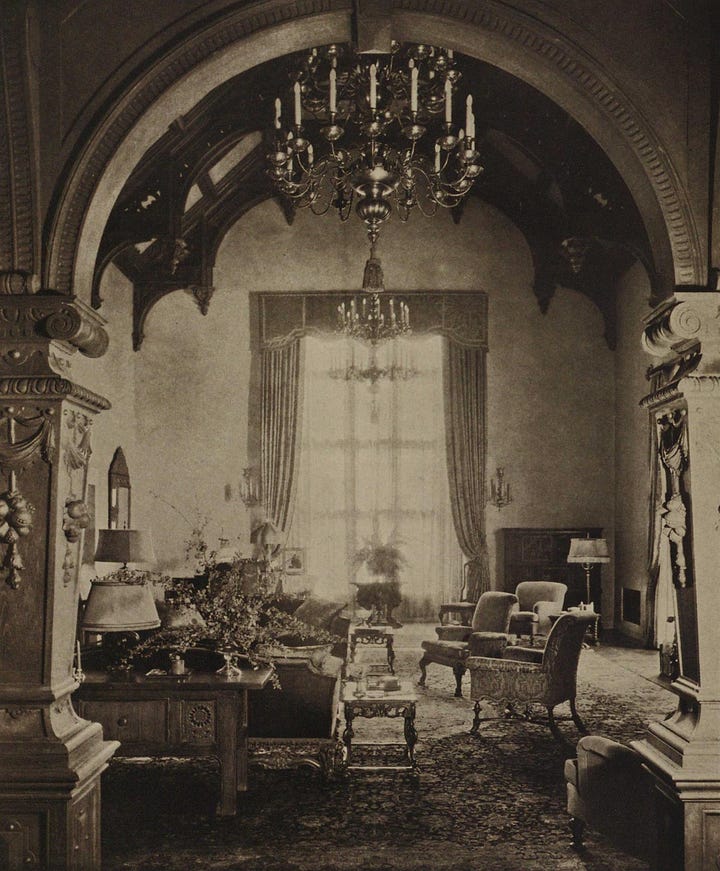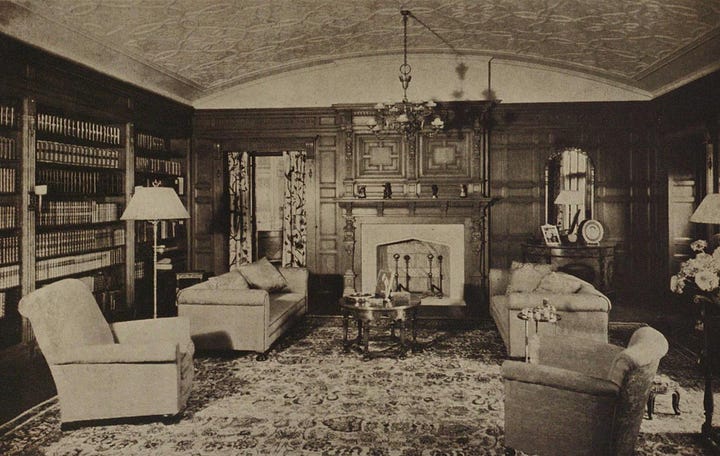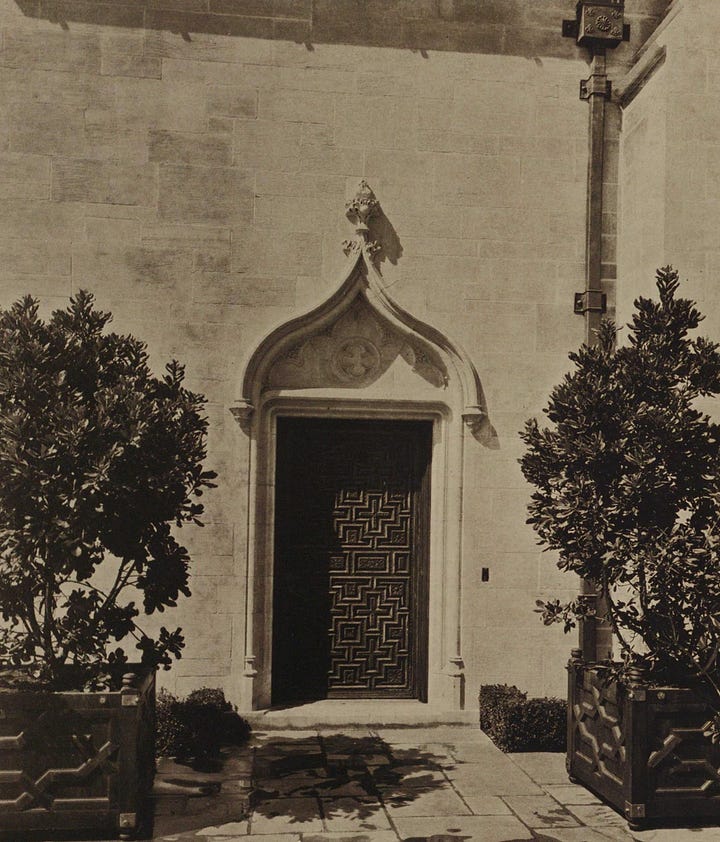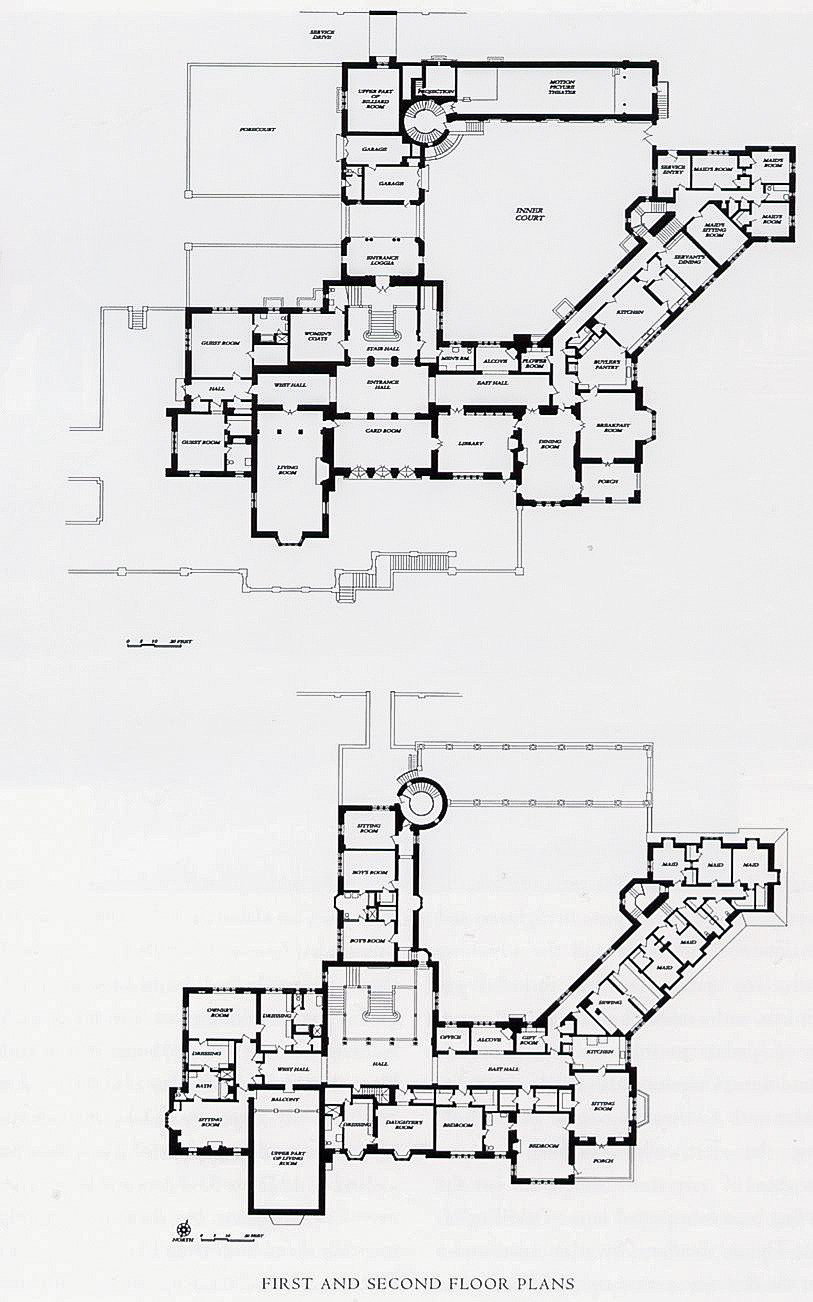Greystone, the Residence of Mr. and Mrs. Edward L. Doheny, Jr.
The Sensational History You've Been Waiting For
In all of Beverly Hills, there isn’t an estate with as notorious and convoluted a history as the Doheny’s fabled Greystone estate. Completed in September 1928, the Gordon Kaufmann designed Greystone mansion was built for oil tycoon Edward L. Doheny (1856-1935) as a gift for his son, Edward "Ned" Doheny, Jr. (1893-1929).1 Born in Fond du Lac, Wisconsin, the elder Doheny would join the U.S. Geological Survey in 1873 before prospecting for gold in South Dakota, Arizona Territory, and New Mexico Territory.2 In 1891, Doheny would head even further west, joining his friend and business associate, Charles A. Canfield, in Los Angeles, California.3 By 1892, Doheny would drill the first successful oil well in Los Angeles on the corner of Glendale Boulevard and Colton Street, inaugurating the Los Angeles City Oil Field.4 As a burgeoning oil tycoon, Doheny would parlay his successful LA drilling operations into an international conglomerate by pioneering new oil production near Tampico, Mexico and around Lake Maracaibo in Venezuela, cementing his status as the world’s leading oil man.5
It was in this boom and bust world of oil exploration and prospecting that Ned Doheny, the only son of Edward L. Doheny and his first wife, Carrie Louella Wilkins (1863-1900), was born into. Edward and Carrie’s marriage was marked by the financial insecurity of Edward’s prospecting and oil operations, straining their lives together. The relationship was put under further pressure following their death of their daughter, Eileen (1885-1892), from rheumatic fever.6 In 1899, Edward and Carrie would divorce, with Edward gaining sole custody of their son, Ned.7 Following the disintegration of her family, Carrie would die by suicide after ingesting about six ounces of battery acid in Oakland, California.8 As we can see, even the earliest beginnings of the Doheny family legacy were tinged by death, loss, and uncertainty.
On June 10, 1914, Ned would marry Lucy Marceline Smith (1892-1993) in South Pasadena, California.9 By late 1928, the couple and their five children would move into the Greystone mansion, their Gordon Kaufmann designed English country house in the sky. Perched on a hillside in the Doheny’s family ranch, the home’s style and location were most likely dictated to Kaufmann by his clients, who, eager to distance themselves from the fallout surrounding the elder Doheny’s participation in the Teapot Dome Scandal, sought a home that proclaimed their desire for feudal stability, a home with a patrician outlook, a home that commanded respect above all else. The home’s Tudor Revival style is paired with Classical Italian arches and columns, further fortifying the home with symbols of aristocratic authority.
At 46,000 square feet, Greystone was by far Kaufmann’s largest residential commission. The home is accessed via a long driveway through the Paul Thiene designed grounds, ushering you up to the home’s covered entry loggia. Once inside, I find the home’s staircase reminiscent of the von Trapp family’s villa in The Sound of Music, how about you? The first floor plan truly provides for everything—men’s and women’s first floor dressing rooms, a guest wing, the enfiladed living room, card room, library, dining room, and breakfast room, all connected via the home’s central hallway. The home’s expansive service wing, including a separate maid’s sitting room, is mirrored by a garage and leisure wing containing the billiards room and motion picture theatre.
Upstairs we have six bedroom suites, with the primary suite occupying a wing al its own, boasting his and hers dressing rooms with attached baths in addition to a shared private sitting room. I love the little alcove off the east hall—a thoughtful touch providing a more human scale in such a formidably large house.


The home’s large arrival court is sandwiched between an Italian-inspired retaining wall and Kaufmann’s clean lined interpretation of the Tudor Revival style. This view may seem familiar to you as it’s been featured in movies and in television shows such as Gilmore Girls.


The home’s entry hall continues Kaufmann’s trend of braiding the Tudor and Italian Renaissance Revival styles by combining a broken pediment over the front door with the more English style intricately carved staircase. I can’t get over the lower hall’s intricate plaster ceiling paired with it’s equally impressive wood paneled walls—simply sublime!


The living room is a true medieval fantasy, possessing an intricately beamed ceiling, carved wood panelling, and an immense, ornate fireplace, all overlooking the southern views of Beverly Hills.




The home’s interiors, curated by Cheesewright Studios, continued Kaufmann’s braiding of English and Italian precedents, creating modern, livable interiors in what was Los Angeles’ largest private home. I’m particularly drawn to the beautiful tile and mural work in the card room and the modern, Art Deco inspired ladies’ dressing room, with its effervescent furnishings, is a shimmering jewel box within a more staid interior composition.




Back outside, we can truly appreciate Kaufmann’s commitment to the Tudor and Italian styles—the home’s distinct buttresses, ornate chimneys, ogee arches, mullioned windows, Ionic ordered columns, and intricately carved wooden doors.


For the design of the estate’s garage, Kaufmann drew inspiration from the work of Edwin Lutyens, calling upon Lutyens’ mighty buttresses to further connect the building to the rolling landscape of the estate. For more leisurely activities, Kaufmann also designed the large pool house, providing a more casual and intimate space within the boundaries of the home’s formal grounds. All told, the home’s total cost, including grading, landscaping, and construction, topped $3.1 million.10
However, all was not well within Fortress Doheny. As mentioned previously, the family was embroiled in the Teapot Dome Scandal, where the elder Edward Doheny was accused of offering a $100,000 bribe to the United States Secretary of the Interior, Albert Fall, for oil leases near Teapot Dome, Wyoming.11
As the Teapot Dome investigation began to pan out, interest soon feel on the young Ned Doheny and his close friend and personal secretary, Hugh Plunkett. Both men were implicated in the scandal as it is believed they personally delivered a black valise holding $100,000 in cash to Secretary Fall himself.12 Soon, both men were schedule to provide testimony on their involvement in the case in Washington D. C., bringing much anguish and unease to Plunkett. The situation would take a turn around 11:00pm on the night of February 16, 1929, a mere five months after the family moved into their new estate, when Plunkett arrived at the Doheny mansion after driving up from his apartment in Hollywood.13 After passing through the attended gate, Plunkett used his personal key to enter the house, making his way up to the bedroom allotted to him on the second floor of the home’s east wing. Plunkett, using the home’s personal switchboard, then called up the man of the house, Ned Doheny, to discuss a personal matter, asking Doheny to join him in his bedroom.14
Dressed in a silk robe, Doheny entered the bedroom only to be shot by Plunkett for reasons that are still not completely known to this day. Downstairs, Lucy Doheny had been reading in the library when she heard a gun shot ring out around 11:00pm, yet, as shared in contemporary press reports, she did not call the police, but instead called the family doctor, who arrived about 20 minutes later. After arriving in the east wing, the doctor and Mrs. Doheny reported that they were greeted by the sight of Hugh Plunkett, still holding the gun, before he dashed back inside the bedroom and another gunshot soon split the silence.15 Upon entering the room, the doctor and Mrs. Doheny would find both men dead on the floor, blood pooling around them.
However, it wouldn’t be until about 2 o’clock in the morning on February 16th that the police would be telephoned to report the accident. However, what was LA’s wealthiest family up to in those two hours prior to the arrival of the police? It was reported that the bodies had been moved prior to the police being able to photograph and catalog the crime scene, yet what else could have been tampered with? At the time, the press speculated that Plunkett has requested a raise, which Doheny denied, as a possible motive. Another theory, that Plunkett killed Doheny and himself for fear that their secret love affair would be discovered, was soon headlining newspapers across the country. However, is this the true story, or the most convenient one? After all, the murder weapon was a gun owned not by Plunkett, but by Doheny himself.
Following their deaths, both men would be buried close together in Glendale’s non-denominational Forest Lawn Memorial Park, despite the fact that the Doheny family were staunch Catholics, raising even more questions.
Lucy Doheny would soon marry business and oil man Leigh Battson, and remained at Greystone to raise her children. Following her marriage to Battson, the new couple would commission architect Roland Coate to design their Lake Arrowhead spread, Happy Landing, in the romantic Norman Revival style to provide an additional countryside escape to their property portfolio.
The Battsons would sell Greystone in 1955 to Mr. Henry Crown of Chicago, who instead of moving in, would lease the home out for use as a filming location before being purchased by the City of Beverly Hills in 1965 for $1.3 million.16 Following an extensive renovation process, the home would reopen as a public park, and would be recognized on the National Register of Historic Places in 1976, thereby cementing its historical importance to the City of Beverly Hills and Los Angeles at large. And that concludes our wild ride through the history or Greystone—what did you think?!
Project: Greystone, the Residence of Mr. and Mrs. E. L. Doheny, Jr., 1928
Architect: Gordon Kaufmann
Landscape Architect: Paul Thiene
Location: Beverly Hills, California
“History of Greystone,” History of Greystone | Beverly Hills, CA, accessed March 13, 2025, https://www.beverlyhills.org/426/History-of-Greystone.
“Edward L. Doheny,” Wikipedia, March 11, 2025, https://en.wikipedia.org/wiki/Edward_L._Doheny.
Ibid.
Ibid.
“History of Greystone.”
“Edward L. Doheny.”
Ibid.
“Carrie Louella Wilkins Doheny (1862-1900) - Find...,” Find a Grave, accessed March 13, 2025, https://www.findagrave.com/memorial/21557/carrie-louella-doheny.
“Lucy Marceline Smith,” FamilySearch.org, accessed March 13, 2025, https://ancestors.familysearch.org/en/LW3L-8MR/lucy-marceline-smith-1892-1993.
“History of Greystone.”
David Patrick Columbia, “The Continuing Mystery of the Greystone Mansion Murders,” New York Social Diary, April 12, 2022, https://www.newyorksocialdiary.com/the-continuing-mystery-of-the-greystone-mansion-murders/.
Ibid.
Ibid.
Ibid.
Ibid.
“History of Greystone.”






